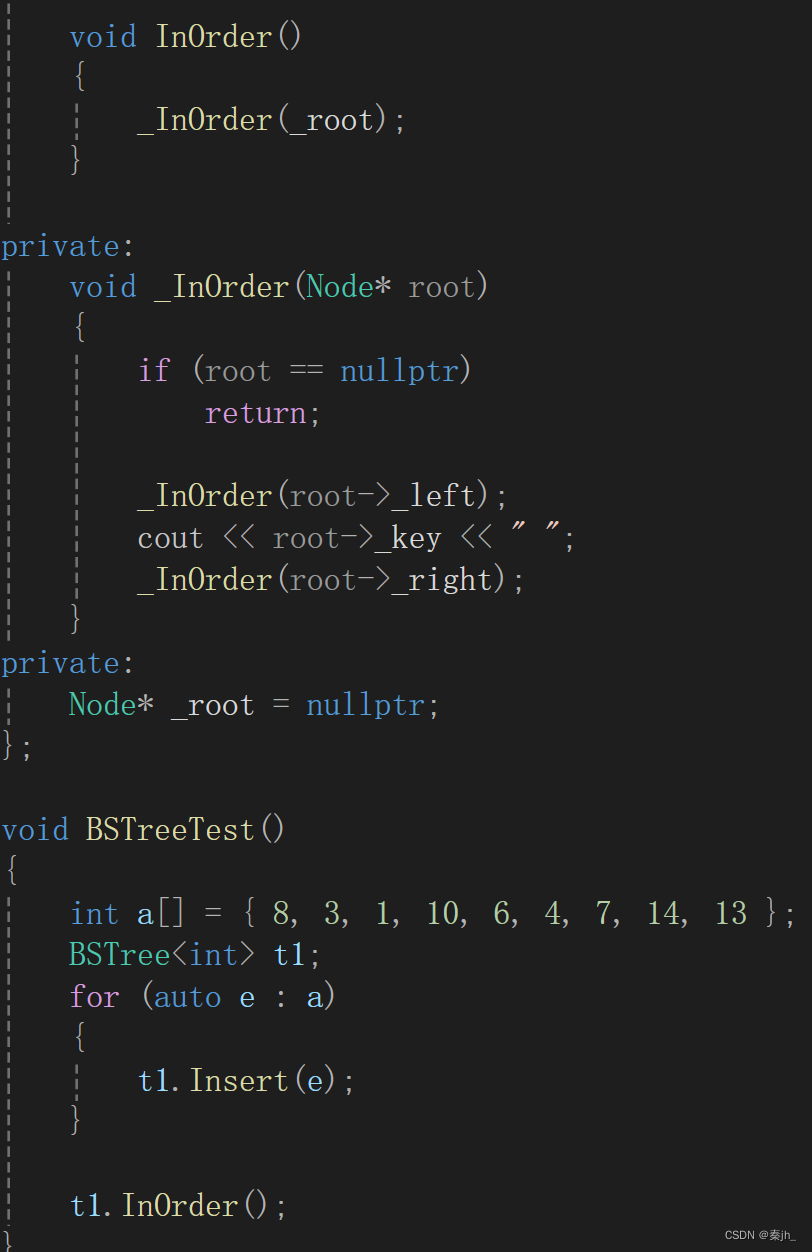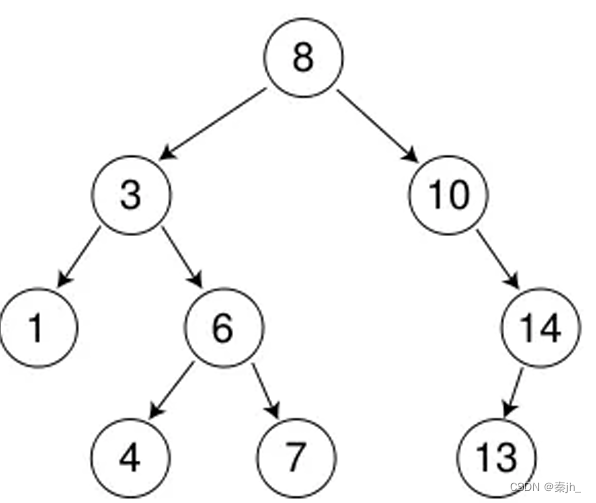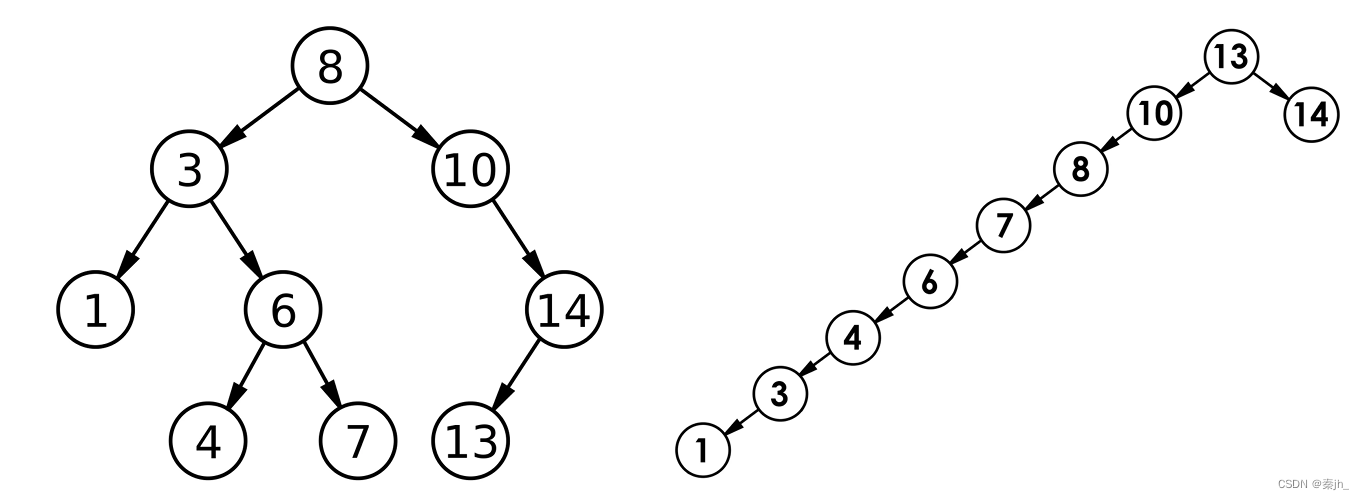阅读量:0
🌈个人主页:秦jh_-CSDN博客
🔥 系列专栏:https://blog.csdn.net/qinjh_/category_12575764.html?spm=1001.2014.3001.5482

目录
前言
💬 hello! 各位铁子们大家好哇。
今日更新了二叉搜索树的相关内容
🎉 欢迎大家关注🔍点赞👍收藏⭐️留言📝
二叉搜索树
概念
二叉搜索树又称二叉排序树,它或者是一棵空树,或者是具有以下性质的二叉树:
- 若它的左子树不为空,则左子树上所有节点的值都小于根节点的值
- 若它的右子树不为空,则右子树上所有节点的值都大于根节点的值
- 它的左右子树也分别为二叉搜索树

操作
查找
- 从根开始比较,查找,比根大则往右边走查找,比根小则往左边走查找。
- 最多查找高度次,走到到空,还没找到,这个值不存在。
插入
- 树为空,则直接新增节点,赋值给root指针
- 树不空,按二叉搜索树性质查找插入位置,插入新节点 。默认不能冗余,如果已经有相同的值了,就插入失败。
中序遍历

二叉搜索树的中序遍历,其实就是升序后的排序。因为根节点是私有的,这里不适合用友元。所以对于递归的函数,可以弄一个子函数为私有,套一层在外面,这里就不需要传形参了,不需要访问私有的根节点了。
删除

上图是我们即将使用的搜索二叉树模型。
首先查找元素是否在二叉搜索树中,如果不存在,则返回, 否则要删除的结点可能分下面四种情 况:
- 要删除的结点无孩子结点(情况1)
- 要删除的结点只有左孩子结点(情况2)
- 要删除的结点只有右孩子结点(情况3)
- 要删除的结点有左、右孩子结点(情况4)
实际上,情况1可以和2,3合并起来,不需要额外判断。
实际删除过程:
- 情况2:删除该节点且使该节点的父节点指向该节点的左孩子。
- 情况3:删除该节点且使该节点的父节点指向该节点的右孩子。
- 情况4:在它的右子树找最左节点进行交换,然后再处理该节点的删除问题。(或者找左子树的最右节点进行替换)
删除的完整代码:
bool Erase(const K& key) { Node* cur = _root; Node* parent = nullptr; while (cur) { if (cur->_key < key) { parent = cur; cur = cur->_right; } else if (cur->_key > key) { parent = cur; cur = cur->_left; } else { //删除 //左为空,父亲指向我的右 if (cur->_left == nullptr) { if (cur == _root) { _root = cur->_right; } else { if (cur == parent->_left) { parent->_left = cur->_right; } else { parent->_right = cur->_right; } } delete cur; } else if (cur->_right == nullptr) { if (cur == _root) { _root = cur->_left; } else { //右为空,父亲指向我的左 if (cur == parent->_left) { parent->_left = cur->_left; } else { parent->_right = cur->_left; } } delete cur; } else { //左右都不为空,替换法删除 //查找右子树的最左节点替代删除(也可找左子树的最右节点替换) //注意删除根节点的特殊情况,此时rightmin的父亲为cur Node* rightMinParent = cur; Node* rightMin = cur->_right; while (rightMin->_left) { rightMinParent = rightMin; rightMin = rightMin->_left; } swap(cur->_key, rightMin->_key); //判断rightmin在父亲的左边还是右边 //rightmin左边为空,所以rightmin的父亲指向rightmin的右边 if(rightMinParent->_left==rightMin) rightMinParent->_left = rightMin->_right; else rightMinParent->_right = rightMin->_right; delete rightMin; } return true; } } return false; }
注意,当删除全部节点时,需要更新根节点,如上图。
二叉搜索树的应用
K模型:K模型即只有key作为关键码,结构中只需要存储Key即可,关键码即为需要搜索到的值。
KV模型:每一个关键码key,都有与之对应的值Value,即的键值对。
K模型代码:
namespace key { template<class K> struct BSTreeNode { BSTreeNode<K>* _left; BSTreeNode<K>* _right; K _key; BSTreeNode(const K& key) :_left(nullptr) , _right(nullptr) , _key(key) {} }; template<class K> class BSTree { typedef BSTreeNode<K> Node; public: bool Insert(const K& key) { if (_root == nullptr) { _root = new Node(key); return true; } Node* cur = _root; Node* parent = nullptr; while (cur) { if (cur->_key < key) { parent = cur; cur = cur->_right; } else if (cur->_key > key) { parent = cur; cur = cur->_left; } else { return false; } } cur = new Node(key); if (parent->_key > key) { parent->_left = cur; } else { parent->_right = cur; } return true; } bool Find(const K& key) { Node* cur = _root; while (cur) { if (cur->_key < key) { cur = cur->_right; } else if (cur->_key > key) { cur = cur->_left; } else { return true; } } return false; } bool Erase(const K& key) { Node* cur = _root; Node* parent = nullptr; while (cur) { if (cur->_key < key) { parent = cur; cur = cur->_right; } else if (cur->_key > key) { parent = cur; cur = cur->_left; } else { //删除 //左为空,父亲指向我的右 if (cur->_left == nullptr) { if (cur == _root) { _root = cur->_right; } else { if (cur == parent->_left) { parent->_left = cur->_right; } else { parent->_right = cur->_right; } } delete cur; } else if (cur->_right == nullptr) { if (cur == _root) { _root = cur->_left; } else { //右为空,父亲指向我的左 if (cur == parent->_left) { parent->_left = cur->_left; } else { parent->_right = cur->_left; } } delete cur; } else { //左右都不为空,替换法删除 //查找右子树的最左节点替代删除(也可找左子树的最右节点替换) Node* rightMinParent = cur; Node* rightMin = cur->_right; while (rightMin->_left) { rightMinParent = rightMin; rightMin = rightMin->_left; } swap(cur->_key, rightMin->_key); if (rightMinParent->_left == rightMin) rightMinParent->_left = rightMin->_right; else rightMinParent->_right = rightMin->_right; delete rightMin; } return true; } } return false; } void InOrder() { _InOrder(_root); cout << endl; } private: void _InOrder(Node* root) { if (root == nullptr) return; _InOrder(root->_left); cout << root->_key << ":" << root->_val << endl; _InOrder(root->_right); } private: Node* _root = nullptr; }; void BSTreeTest1() { int a[] = { 8, 3, 1, 10, 6, 4, 7, 14, 13 }; BSTree<int> t1; for (auto e : a) { t1.Insert(e); } t1.InOrder(); t1.Erase(8); t1.InOrder(); for (auto e : a) { t1.Erase(e); t1.InOrder(); } } }KV模型代码:
namespace key_value { template<class K,class V> struct BSTreeNode { BSTreeNode<K,V>* _left; BSTreeNode<K,V>* _right; K _key; V _val; BSTreeNode(const K& key,const V& val) :_left(nullptr) , _right(nullptr) , _key(key) ,_val(val) {} }; template<class K,class V> class BSTree { typedef BSTreeNode<K,V> Node; public: bool Insert(const K& key,const V& val) { if (_root == nullptr) { _root = new Node(key,val); return true; } Node* cur = _root; Node* parent = nullptr; while (cur) { if (cur->_key < key) { parent = cur; cur = cur->_right; } else if (cur->_key > key) { parent = cur; cur = cur->_left; } else { return false; } } cur = new Node(key,val); if (parent->_key > key) { parent->_left = cur; } else { parent->_right = cur; } return true; } Node* Find(const K& key) { Node* cur = _root; while (cur) { if (cur->_key < key) { cur = cur->_right; } else if (cur->_key > key) { cur = cur->_left; } else { return cur; } } return nullptr; } bool Erase(const K& key) { Node* cur = _root; Node* parent = nullptr; while (cur) { if (cur->_key < key) { parent = cur; cur = cur->_right; } else if (cur->_key > key) { parent = cur; cur = cur->_left; } else { //删除 //左为空,父亲指向我的右 if (cur->_left == nullptr) { if (cur == _root) { _root = cur->_right; } else { if (cur == parent->_left) { parent->_left = cur->_right; } else { parent->_right = cur->_right; } } delete cur; } else if (cur->_right == nullptr) { if (cur == _root) { _root = cur->_left; } else { //右为空,父亲指向我的左 if (cur == parent->_left) { parent->_left = cur->_left; } else { parent->_right = cur->_left; } } delete cur; } else { //左右都不为空,替换法删除 //查找右子树的最左节点替代删除(也可找左子树的最右节点替换) Node* rightMinParent = cur; Node* rightMin = cur->_right; while (rightMin->_left) { rightMinParent = rightMin; rightMin = rightMin->_left; } swap(cur->_key, rightMin->_key); if (rightMinParent->_left == rightMin) rightMinParent->_left = rightMin->_right; else rightMinParent->_right = rightMin->_right; delete rightMin; } return true; } } return false; } void InOrder() { _InOrder(_root); cout << endl; } private: void _InOrder(Node* root) { if (root == nullptr) return; _InOrder(root->_left); cout << root->_key << " "; _InOrder(root->_right); } private: Node* _root = nullptr; }; void BSTreeTest2() { BSTree<string, string> dict; dict.Insert("string", "字符串"); dict.Insert("left", "左边"); dict.Insert("insert", "插入"); string str; while (cin >> str) { BSTreeNode<string, string>* ret = dict.Find(str); if (ret) { cout << ret->_val << endl; } else { cout << "找不到" << endl; } } } } KV模型只需要在K模型的基础上进行修改即可。
性能分析

根据二叉树结构的不同,时间复杂度也会不一样。
最优情况:二叉搜索树为完全二叉树(或者接近完全二叉树),时间复杂度:O(logN)
最差情况:二叉搜索树退化为单支树(或者类似单支),时间复杂度:O(N)
